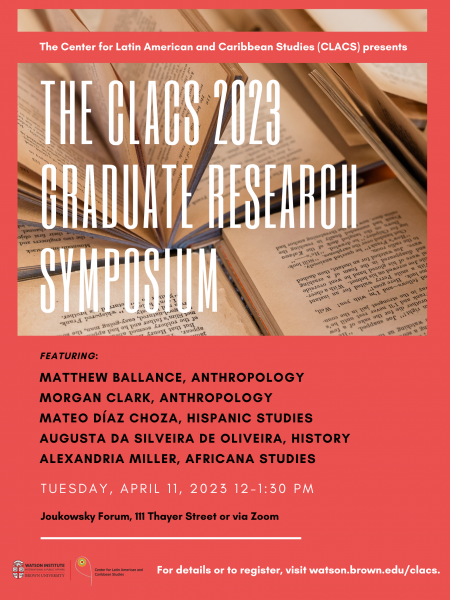Morgan Clark, Anthropology
Three Seasons at La Cuernavilla: New Perspectives on the Water Supply and the Watchtower
Defined by its lengthy system of ramparts and ditches, La Cuernavilla is the largest known ancient defensive settlement in the Maya region. Over the course of three seasons, the archaeological team of Proyecto Arqueológico El Zotz (PAEZ) has conducted surveys, excavations, and environmental analyses to collect evidence about the dates of La Cuernavilla’s occupation, how the site might have been used, how it was sustained, and whether those living in its palatial and residential structures were subsidiaries of nearby Tikal. Now that the project is over, PAEZ archaeologists are collating their final interpretations. The focus of this presentation will be the results of excavations and analyses in two operations: La Cuernavilla’s artificial water reservoir and the Teotihuacan-inspired “Talud Tablero” watchtower overlooking the palace.
Mateo Díaz Choza, Hispanic Studies
Self-Sacrifice and the politics of voice in Salvador Allende’s Last Speech (1973). On September 11th 1973, Chilean President Salvador Allende delivered his last speech while the Presidential Palace was being bombed during Augusto Pinochet’s coup d’état. During the speech, he says he will face death if necessary to defend the principles of his democratically-elected government. His speech was broadcast live exclusively by Radio Magallanes since all the other radio stations had already been bombed by the Air Force, acting on Pinochet’s orders. Though the recorded speech remains an emotionally-charged touchstone for the Chilean and Latin American left, I will argue here that it also mobilizes a discourse of political self-sacrifice that gained wide currency during the 60s and the 70s. By undertaking a close reading of the speech and examining its cultural context, I will analyze how a deeply institutional politician ultimately decided to adopt the revolutionary language of the time. Characterized by many performative elements, the speech posits Allende’s physical voice as his legacy and frames his sacrifice as the seed that will eventually reverse the conservative turn that brought Pinochet to power.
Augusta da Silveira de Oliveira, History
"Between Authoritarianism and Misogyny: Lesbian Activism and the Brazilian Homosexual Press during the Military Dictatorship"
This paper examines the role of lesbian activism within the emerging homosexual press in Brazil during the country's dictatorship period, spanning from 1964 to 1985. I argue that lesbian independent activism emerged as a response to the misogyny within the predominantly male homosexual movement and press, while also aligning with these groups in the common struggle against the dictatorship. By the late 1970s, a liberalizing political climate enabled the organization of civil society. Along with a politically engaged homosexual movement, an alternative homosexual press contributed to the public debate on rights and visibility. The first politicized homosexual paper, the monthly Lampião da Esquina, was founded in 1978. However, Lampião failed to give equal space for each minoritized group in its pages and on its editorial board, leading lesbian groups to create their own publications to communicate with their target audiences based on mutual identification. Over time, some members of Lampião's editorial board became increasingly critical of social movements and their political demands, opposing what they saw as leftist co-optation. Furthermore, the fact that most women who contributed to the periodical were also involved with homosexual and lesbian politicized groups and feminist organizations kept them away from Lampião. By situating lesbian activism within the broader political and social context of the Brazilian dictatorship, I explore an understudied aspect of Brazilian history and offer new insights into the complex interplay between gender, sexuality, and politics.
Alexandria Miller, Africana Studies
“Lioness Order:” Women in the Business and Legacy of Reggae Music
Abstract: Though often overlooked in favor of prominent male reggae artists, Jamaican women have played an integral role in the growth and development of reggae since its inception. Though women have often been underrepresented as artists within the genre, they make up a significant fraction and have been even more successful than men in the business side of reggae music, occupying what some may call "background roles" in entertainment law, artist management, and publicity. As part of my dissertation's longer history of women in reggae music, this presentation situates women’s intellectual contributions in the growth and notoriety of reggae through their influence in the popular music’s national and international development as business organizers. In particular, I trace the genealogy of Jamaican female music entrepreneurs, activists, and politicians to clarify how they have navigated entrepreneurship as female cultural producers, revolutionizing traditional definitions of Caribbean women’s entrepreneurship while also outlining how their business efforts have been critical to reggae’s international success.


